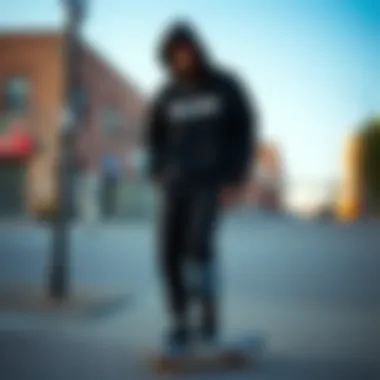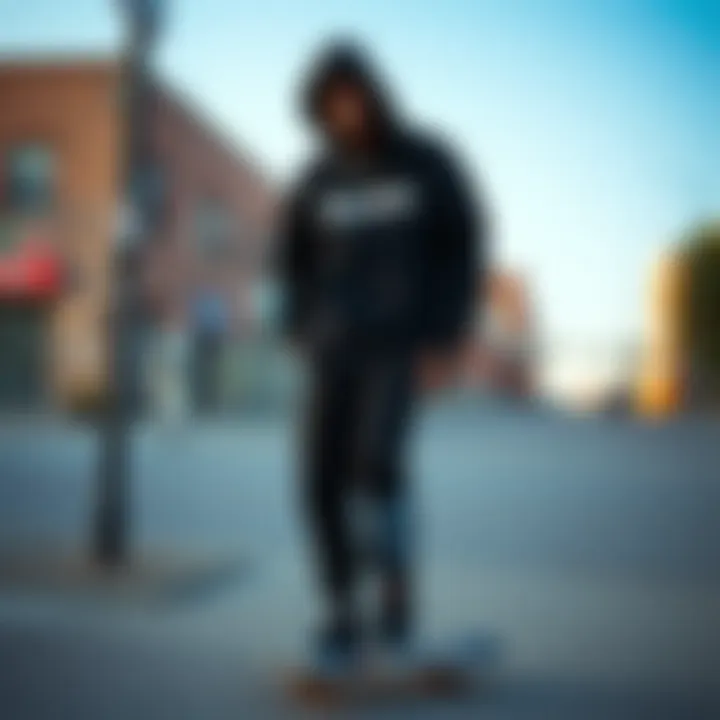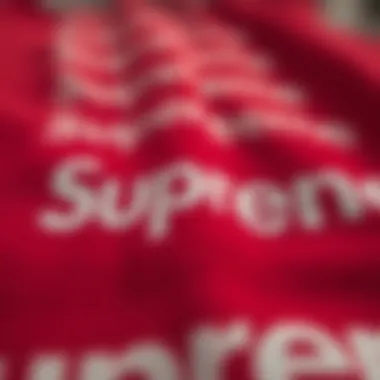Supreme Apparel's Influence on Skateboarding Culture


Intro
The relationship between fashion and skateboarding is a tapestry woven with threads of individuality and the spirit of rebellion. Skateboarding is not just a sport, it’s a culture, a lifestyle, and a means of expression. Central to the evolution of skate culture has been Supreme, a brand that originated from humble beginnings in New York City but has since become a global sensation. This article delves into the transformative role of Supreme apparel within the skateboarding community, highlighting how it has redefined style while maintaining an ode to the authenticity that skaters hold dear. We will explore the brand's collaborative efforts, its strategic positioning in streetwear, and what all of this means for both the skateboarders and the broader cultural landscape.
Skateboarding Techniques
Mastering the Basics
Before Supreme even hit the scene, mastering the fundamentals of skateboarding was the foundation upon which all great skaters built their skills. From finding your balance on a board to perfecting basic tricks like the ollie and kickflip, these core techniques form the backbone of every skater's journey. An understanding of these elements is crucial for anyone looking to be part of the skate community, and they provide a gateway for the development of more advanced skills.
Advanced Tricks and Stunts
Once basics are under your belt, you venture into the world of advanced tricks—those that require not just skill, but a certain attitude. Tricks like the 360 flip or noseblunt slide are the crown jewels that display a skater's dedication. Interestingly, Supreme has played a significant part in elevating these skills by sponsoring skaters who push boundaries and redefine what’s possible on a board. The brand has leveraged this relationship to celebrate the artistry of skateboarding while simultaneously promoting its apparel. In essence, every trick attempted is a reflection of both the skater's personal style and the influence of the clothing they wear.
As Supreme continues to collaborate with top-tier athletes and innovators, it instills in the culture a drive to not only improve technically but also to express one’s self uniquely through their fashion choices.
Gear and Equipment
Skateboard Types and Features
Using the right gear can differentiate between a mediocre and a stellar performance on the board. Supreme has influenced how skateboarders view their equipment—moving from purely functional aspects to a more stylistic approach. Different types of skateboards, such as cruiser boards or street decks, offer varying experiences, impacting how tricks are performed and how style is presented.
Essential Safety Gear
While tricks and style are integral to skate culture, safety cannot take a back seat. Helmets, knee pads, and wrist guards are essential. Supreme, though primarily known for its apparel, has also touched on promoting safety gear in a way that blends with their edgy, urban aesthetic. The choice of quality safety gear signifies a skater's commitment not just to style, but to the sport itself.
Ending
Through the lens of Supreme, we examine how a brand can simultaneously uphold authenticity while expanding into the commercial sphere. The interplay between traditional skate culture and contemporary fashion has created a diverse landscape for skaters and enthusiasts alike. This article aims to dissect these layers, providing insights that resonate with skateboarders, parents, and retailers, ultimately crafting a holistic understanding of Supreme's role in shaping the culture today.
Foreword to Supreme Apparel
Supreme Apparel stands as a beacon within the landscape of skate culture, weaving a thread that connects the rebellious spirit of skateboarding with high-fashion elements. This brand's influence goes beyond mere clothing; it captures an essential ethos prevalent among skateboarders, transcending geographical boundaries. Its importance lies not only in what it represents—a platform for self-expression and individuality—but also how it has transformed perceptions of skate culture in the broader societal context. By dissecting the fabric of Supreme and its connection to skateboarding, one can better appreciate the blend of artistry, community, and commercialism that defines modern streetwear today.
Origins and Founding
The journey of Supreme began in 1994, birthed by James Jebbia in New York City. It started as a humble skate shop, opening its doors in a modest location on Lafayette Street. Unlike conventional skate shops bustling with typical board brands, Supreme sought to create a space mirroring the lively skate scene around it while fostering creativity. Jebbia's vision was simple yet profound: cultivate an inclusive environment for both skaters and artists. This informal yet passionate beginning laid the groundwork for what Supreme would ultimately become—a cultural icon.
One key aspect of Supreme’s early days was its immediate embrace of the local skateboarding community. While some brands focused solely on performance gear, Supreme mixed elements of art and street culture, appealing to a broader audience. Its first collection featured simple yet bold graphics that spoke volumes, often inspired by punk rock and hip-hop aesthetics, ensuring that shoppers resonated with the clothing on multiple levels.
Vision and Mission
Supreme’s mission pivots on enhancing the skateboarding experience while preserving the authenticity of the culture. At its core, the brand wasn’t just about selling apparel; it was about crafting a lifestyle that resonated with the ethos of skaters. Emphasizing a deep respect for the roots of skateboarding, Supreme aimed to bridge the gap between the grassroots culture and mainstream success without diluting its essence.
With every collection launch, Supreme continues to strive for innovation without losing sight of its foundational values: community, creativity, and authenticity. The dedication to collaborating with artists and influential figures in various domains, from contemporary art to music, exemplifies this mission.
In this ever-shifting landscape of streetwear, the story of Supreme serves as a commendable lesson on balancing commercial ambition with the soul of skate culture. By continuously challenging norms and exploring new creative horizons, Supreme not only reflects the identity of the skate community but also boldly reshapes it.
"Supreme is more than just a clothing line; it's a narrative of rebellion, creativity, and the unyielding spirit of skateboarding."
Supreme and Skateboarding Culture
Skateboarding culture is not just about tricks on a board; it embodies an entire way of life, a rebellious ethos woven through community and identity. In this vibrant atmosphere, Supreme Apparel holds a major role that goes beyond simple fashion statements. The brand has made an impressive mark, intertwining itself with the culture’s evolution while reflecting its values and styles.
Skateboarder Influence


Supreme, founded in 1994, made its initial impact by catering specifically to skateboarders. From the get-go, the brand positioned itself not only as clothing but an essential part of skate culture. In a way, Supreme became synonymous with skating, like peanut butter and jelly—each enhancing the other's appeal. Skaters, drawn to Supreme’s edgy design and exclusivity, find themselves not just wearing a brand but endorsing a lifestyle.
This relationship can be seen in the brand’s choice of ambassadors—some of the most influential skateboarders in history. Tony Hawk, Sean Pablo, and Lucien Clarke are just a few names associated with Supreme, each carving out a unique path while remaining connected to the brand. These pros bring credibility to Supreme, fostering a sense of authenticity that resonates deeply within skate communities. Not only do they represent Supreme but also reflect the core values of skateboarding: individuality, creativity, and an undeniable passion for the culture. In turn, this has encouraged new generations of skaters to embrace the brand, solidifying its foundation within the community.
Impact on Identity and Community
The influence of Supreme on identity within skate culture cannot be overstated. As skaters express themselves through their boards and tricks, the clothing they don becomes a canvas of personal storytelling. Supreme's distinctive logo and unique collaborations serve as status symbols, marking both affiliation and belonging. This creates an intricate web of identity signifiers—wearing Supreme is not just about the gear, but about becoming part of a larger cultural narrative.
"Supreme isn’t just a brand; it's a badge of belonging for many skaters, representing values that go beyond fashion."
Community ties are strengthened as the brand often hosts skate events and participates in competitions, bringing together diverse groups under the same roof. Such initiatives support local skate parks, funding initiatives that directly benefit the community. Through workshops and contests, Supreme positions itself as a facilitator, emphasizing that skateboard culture thrives best when collaboration overshadows competition.
In the grand scheme, the relationship between Supreme and skateboarding culture captures an evolving dance between commerce and authenticity. It underscores a pivotal point—how a brand can shape identity while nurturing a community based on shared interests and values. As skaters continue to push the boundaries of creativity, the influence of Supreme will likely remain a cornerstone of skate culture, reflecting its ever-changing landscape.
Collaborations and Limited Releases
In the world of Supreme apparel, collaborations and limited releases play a pivotal role in distinguishing the brand from the vast sea of streetwear options. This strategy not only bolsters Supreme's brand image but also solidifies its unique space within skate culture. There’s a certain je ne sais quoi surrounding these collaborations that fuels demand and creates a buzz that permeates the community. By teaming up with various artists and brands, Supreme has tapped into the creative hearts of skateboarders, thus crafting a narrative that extends beyond mere fabric and stitching.
Artistic Collaborations
Supreme's artistic collaborations are a treasure trove of creativity, where skate culture intersects with high art. When Supreme partners with notable artists like Damien Hirst or Marilyn Minter, it’s not just about their names—it's about a conversation being sparked. These collaborations often yield limited edition pieces that transform a simple graphic tee into a canvas of cultural commentary. The pieces are designed with more than aesthetics in mind; they channel the vibe of skateboarding while elevating art to fashion.
Such artistic ventures make profound statements, often challenging societal norms or evoking dialogues about identity and culture. This makes each drop feel like an event, mingling those who appreciate art with those who love skating. As skateboarding itself is an art form, these collaborations resonate deeply and establish a kinship in the community, ensuring the brand remains at the forefront of both skating and art.
Brand Collaborations
Collaborations with other brands have proved to be a winning formula for Supreme. By aligning with entities like Nike or The North Face, Supreme has managed to blend its skate-centric ethos with mainstream appeal. This kind of cross-pollination results in products that are not only functional but also steeped in this streetwear culture the brand represents.
One notable example is the Supreme x Nike Air Force 1, a sneaker that bridged the gap between skateboarding and high fashion, becoming a sought-after item amongst sneaker aficionados and skateboarders alike. These collaborations enable Supreme to expand its reach and capitalize on the brand identities of established names. It widens their customer base while also reinforcing their status in the skate community as purveyors of both style and practicality.
The Hype Phenomenon
The concept of hype is almost synonymous with the Supreme brand; it’s a phenomenon that transcends typical consumer behavior. Limited releases create a fervor that drives demand to dizzying heights. The simple act of knowing that an item is scarce adds a layer of desirability. When someone talks about waiting in line for hours, it’s not just a purchase; it’s an experience.
When Supreme drops a highly anticipated item, the conversations escalate through social media platforms, often fueled by influencers or resellers, turning casual consumers into fervent participants of the hype machine. This environment is where exclusivity transforms into prestige, with fans proudly discussing their latest finds.
"The immediate connection between scarcity and value makes Supreme a unique player in the streetwear game."
Not only do these tactics benefit the brand's visibility, they also impact resale markets dramatically. Prices soar within minutes after a drop, flipping the narrative around the product from simply being
The Aesthetic of Supreme Apparel
The aesthetic of Supreme apparel is not just a set of design principles; it's a cultural statement that has become synonymous with skate culture. This segment dives into the significance of the brand's aesthetic choices and how they resonate with the skateboarding community as well as the larger streetwear scene.
Design Elements
Supreme's design elements are a blend of minimalism and striking visuals that reflect the ethos of skate culture. The brand effectively utilizes simple silhouettes alongside bold graphics, creating a unique identity that stands out in a crowded marketplace. T-shirts, hoodies, and jackets often feature a straightforward cut that caters to both functionality and style. This practical approach allows skaters to move comfortably while maintaining a fashionable edge.
- Logos and Text: The iconic Supreme box logo, with its bright red background and bold white font, is more than just a brand marker; it symbolizes an allegiance to the skateboarding lifestyle. This logo is frequently paired with other graphics, ranging from collaborations with world-renowned artists to humorous slogans. It’s this versatile use of branding that keeps the aesthetic fresh and appealing.
- Materials and Craftsmanship: When it comes to materials, Supreme opts for high-quality fabrics that maintain durability during skate sessions. Cotton blends, stitched at key stress points, ensure that pieces hold up well over time. Such attention to quality is crucial for skaters who need gear that can withstand their high-energy lifestyle.
Color Palette and Graphics
The color palette employed by Supreme ranges from muted tones to eye-popping hues, catering to diverse tastes within the skate community. This variety plays a critical role in attracting new fans while retaining loyal customers. Whether it's a classic black and white combo or vibrant splashes of color, Supreme manages to balance between understated and attention-grabbing designs.
- Seasonal Trends: With each season, Supreme refreshes its color offerings and graphic styles, aligning with emerging trends while retaining their core identity. For example, you'll often see earthy tones in their fall collections, which resonate with skater aesthetics during that time of year, while spring collections might feature brighter shades to reflect the changing season.
- Graphic Complexity: Some pieces showcase intricate graphics that tell stories or convey cultural references. For instance, collaborations with artists like Damien Hirst bring forth designs that are not only eye-catching but also provoke thought. These graphic elements often serve as conversation starters among skaters and non-skaters alike.
"Supreme's aesthetic is more than style; it's a way of life that resonates deeply with those who live and breathe skating."


In essence, the aesthetic of Supreme apparel acts as a mirror reflecting the dynamic nature of skate culture itself. By fusing functional design with comprehensive visual storytelling, Supreme not only meets the demands of its audience but also elevates the very essence of streetwear. This commitment to its roots helps the brand maintain relevance while appealing to generations of skaters.
The Commercialization of Skate Culture
The rise of Supreme Apparel has altered the landscape of skate culture significantly, creating a dialogue about its commercialization. In this article, we delve deep into how this shift impacts not only the brand but also the broader context of the skateboarding community. By examining market strategies and their consequences on independent streetwear brands, we gain insight into both the benefits and drawbacks of a commercialized approach to an art form that was once defined by its authenticity.
Market Strategies
Supreme has often navigated the delicate balance between exclusivity and accessibility, employing various market strategies that have made it a household name among skateboarders and fashion enthusiasts alike. One of the core tactics Supreme uses is the concept of 'limited releases.' The brand deliberately restricts the quantity of its merchandise, driving demand sky-high. Collectors and fans worldwide line up—sometimes for days—to get their hands on a fresh drop. This method not only creates buzz but also solidifies Supreme's status as a brand that stands apart from the mass market.
Another significant strategy involves strategic collaborations with renowned artists and other brands. Their partnerships with figures like Takashi Murakami and Nike have undeniably raised the profile of skate culture, drawing in a crowd that may not have previously identified as skateboarders. These collaborations serve to bridge gaps between high fashion and streetwear, establishing Supreme as a pivotal player at the intersection of subculture and mainstream fashion. However, this does raise questions about authenticity and the perception of skate culture. Are those who wear Supreme doing so out of love for the sport, or merely because it's trendy?
On the flip side, this commercialization creates a lucrative ecosystem. With an increasing number of retail locations, Supreme has expanded its reach globally. This growth is accompanied by brand loyalty that seems to border on cult-like. Skateboarders, often seen as nonconformists, may paradoxically find themselves both champions of and subjected to commercial impulses.
Impacts on Independent Brands
As Supreme ascends in the streetwear hierarchy, the impacts on independent skate brands become increasingly pronounced. On one hand, the hype surrounding Supreme can be beneficial, as it brings more visibility to skate culture overall. However, it can also push smaller brands into a corner, struggling to compete with the enormous marketing budgets and collaborations that a powerhouse like Supreme can afford.
Many independent brands find themselves at a crossroads. They can choose to either lean into the commercial strategies that Supreme utilizes or hold steadfast to their roots, focusing on authenticity and grassroots engagement. This dichotomy forces independent brands to make tough choices about how to position themselves in the market.
For example, brands like Almost Skateboards or Baker Skateboards have forged ahead with unique designs that resonate with their loyal customer base. Yet, there's no denying that the ripple effects of Supreme's success can stifle small operations, pushing them to adopt less sustainable growth strategies.
"The more upscale skateboarding becomes, the less it reflects the culture we know and love. It risks losing its soul in the pursuit of profit."
Ethics of Streetwear Production
The streetwear industry, particularly brands like Supreme, has come under scrutiny for the ethical implications surrounding its production. This examination of ethical considerations reveals both the challenges and the responsibilities that come with the fame and success of highly coveted apparel. The recent trend towards sustainability and labor ethics has added heightened interest to how companies align their business practices with values that resonate with consumers, especially within the skate culture that Supreme symbolizes.
In skateboarding culture, the community has often prided itself on individuality and authenticity. Streetwear brands that do not uphold ethical standards may find themselves not only at odds with societal expectations but also alienated from their core consumer base. Therefore, understanding the ethics of streetwear production is crucial as it sheds light on the broader narrative surrounding identity, responsibility, and sustainability in the fashion landscape.
Sustainability Issues
Sustainability remains a hot topic-related to fashion, and the streetwear sector is no exception. Brands like Supreme often face backlash for environmental practices. Producing items on a mass scale takes a considerable toll on the planet, from excessive water usage to pollution. Many consumers are pushing for brands to adopt sustainable materials and ethically produce their clothing. For instance, the use of organic cotton, recycled polyester, or bamboo fabric has gained traction recently, with some brands proving that stylish apparel can also be environmentally friendly.
To highlight this, let’s consider a few notable practices within the industry:
- Eco-friendly materials: Using organic or recycled materials lowers the carbon footprint.
- Transparent supply chains: Offering insights into where and how products are made can build consumer trust.
- Minimized waste: Brands are exploring ways to reduce overproduction through limited drops or made-to-order models.
"In a world so concerned with sustainability, brands need to reflect not just on their profits but on the footprints they leave behind."
Brands like Cotton On and Patagonia often manage to strike a balance between profitability and ethicality, which can lay a pathway for others in the industry, including Supreme, to reevaluate their approaches.
Labor Practices
When it comes to labor practices, the question of fair wages and working conditions cannot be ignored. The streetwear fashion industry has witnessed numerous instances of labor exploitation, especially in developing countries where the production facilities are located. Workers may often find themselves in unsafe environments while being underpaid, working long hours.
For Supreme, addressing these labor concerns is not merely a public relations move; it is about longer-lasting impact in skate and street culture. The brand's willingness to ensure fair wages, safe working conditions, and responsible sourcing is rapidly becoming a benchmark for modern streetwear companies.
Some salient points to consider include:
- Wage discrepancies: Workers in developing nations often earn mere cents a day in comparison to the hefty retail markups on products.
- Working conditions: Safety regulations in factories vary, and many facilities may lack basic healthcare provisions for staff.
- Fair trade certifications: Brands bolstering their image favorably through certifications can both assure consumers and promote ethical sourcing practices.
In summary, as Supreme continues to grow and influence skate culture, the pressure surrounding ethical production will only intensify. Responding to sustainability and labor concerns will not just shape the brand’s identity but also determine its longevity in an increasingly ethically-conscious marketplace.
Consumer Perspectives


In examining the full spectrum of Supreme Apparel's influence on skate culture, one cannot overlook the intimate relationship the brand has cultivated with its consumers. From a simple skate shop in New York City, Supreme has metamorphosed into a cornerstone of modern streetwear, largely due to the brand’s nuanced understanding of its audience's needs and desires. This section delves into two pivotal aspects of consumer perspectives: brand loyalty and the collectibility and resale market.
Brand Loyalty
Brand loyalty is not just a buzzword; it's a phenomenon that Supreme has expertly navigated. Skateboarders are not merely consumers; they are part of a community, and Supreme has tapped into that. By aligning its brand ethos with the lifestyle and attitudes of skaters, Supreme nurtures a sense of belonging among its followers. This loyalty can be seen in:
- Emotional Connections: Supreme has established a narrative that resonates deeply with its audience. This is about more than clothing—it's about identity. For many skateboarders, wearing Supreme is a badge of honor that signifies commitment to an art form rather than mere fashion.
- Cultural Capital: By associating themselves with Supreme, skaters gain cultural cachet that elevates their status within the skateboarding scene. It is not uncommon to hear young skaters boasting about their Supreme gear, viewing it as a means of self-expression.
- Exclusive Access: The brand often engages its loyal fans through limited releases, emphasizing a kinship with its core audience. The excitement generated around each drop fosters a sense of shared experience among fans and advocates.
The combination of these elements has resulted in a fiercely loyal following that not only purchases but actively promotes the brand through social interactions, primarily on platforms like Reddit and Instagram, where skaters showcase their collections and experiences.
Collectibility and Resale Market
The topic of collectibility, particularly in tandem with the resale market, forms a significant part of the conversation surrounding Supreme. Supreme's strategy of limited releases has turned their products into coveted items, creating a robust environment for collectors and resellers alike. Here’s why this is especially noteworthy:
- Scarcity Breeds Demand: Scarcity, by design, drives the desirability of products. When a new item drops, it’s often available in such limited quantities that those who manage to procure it feel an immediate sense of success and status amongst their peers. This, in turn, creates a buzz and garners attention, leading to even higher demand for the next release.
- Resale Value Phenomena: Supreme items, particularly collaborative pieces, often skyrocket in resale value post-release. The resale market has matured into a complex ecosystem, with items frequently being flipped for several times their original price. This phenomenon underscores the perception of Supreme products as investments rather than mere fashion choices.
- Cultural Significance: Items from Supreme are often used as currency within skate culture. Possessing a rare piece can translate to social leverage, establishing a collector's standing within the community.
As the brand pushes into newer collaborations, it becomes essential to recognize how consumer perspectives, particularly in terms of brand loyalty and the dynamics of the resale market, shape the larger narrative of Supreme in skate culture.
"The brand does not just sell apparel; it sells a lifestyle, a community, and a glimpse into the skate culture that many aspire to be a part of."
This intertwining of loyalty, collectibility, and cultural value continues to define not only Supreme's market position but also the evolving nature of skate culture itself.
Future of Supreme Apparel
The landscape of skateboard culture is ever-changing, yet Supreme Apparel stands at the crossroads of tradition and innovation. Knowing what lies ahead for this iconic brand is crucial not just for its survival but also for the preservation of its relationship with the skate community. Understanding the future of Supreme means comprehending the broader societal trends in skate fashion, and how the brand will continue to funnel these into its identity. This section will explore specific elements that lay the groundwork for what’s next for Supreme—influence, adaptability, and strategic vision.
Evolving Trends in Skate Fashion
Skate fashion is a vibrant tapestry that weaves together personal expression, brand loyalty, and cultural history. As we leap into the future, we see the rise of various trends that could determine the trajectory of Supreme. From the influence of street art and the resurgence of retro styles to a growing emphasis on sustainability, skaters are shifting their preferences with the tides.
Skate wear is increasingly reflecting individual personality and lifestyle rather than just functional gear. The aesthetic has evolved from merely utilitarian to a canvas for self-expression. Supreme must remain attuned to these shifting dynamics if it wishes to resonate with current and upcoming generations of skaters. Key trends to watch include:
- Sustainable Materials: More skaters now prioritize eco-consciousness, seeking brands that meet their ethical standards.
- Unisex Apparel: The days of gender-specific clothing in skate culture are fading, as more brands embrace gender-neutral designs.
- Collaborative Designs: Partnerships with local artists or other brands can offer fresh takes on familiar designs, keeping creativity alive.
By embracing these evolving trends, Supreme is in a position to not only maintain its stronghold but also to broaden its appeal.
Maintaining Authenticity
As Supreme navigates the rapidly changing waters of skate fashion, the challenge of maintaining authentic roots becomes paramount. Skaters, the heart and soul of this subculture, have an exceptional ability to discern authenticity. When a brand strays too far into commercial territory, loyalty may diminish—as genuine connections with the community are sacrificed for profit. Maintaining authenticity means staying true to the original mission and values while still engaging with new ideas and innovations.
To retain its place in skate culture, Supreme must:
- Stay Connected to the Community: Engaging with local skaters and artists aids in preserving the brand’s core while fostering new ideas.
- Limit Collaborations: While collaborations can attract attention, overextending into partnerships can dilute brand identity. Choosing collaborations that resonate genuinely with skate culture is key.
- Transparency in Production: Today's consumers demand to know where their clothing comes from and how it’s made. Upholding ethical manufacturing practices builds trust.
Ending
The role of Supreme apparel in the skate culture is akin to that of a tightrope walker balancing between authenticity and commercial viability. This article sheds light on how a brand, once a small skate shop in New York, evolved into a cornerstone of urban fashion. The relationship between Supreme and skateboarders transcends mere product sales; it shapes community identity and personal style.
Supreme’s unique collaborations with prominent artists, musicians, and other brands have set a precedent in the world of streetwear. Years ago, a simple t-shirt design could elevate the status of both the wearer and the artist, signifying not just taste but a lifestyle. Today, when one sees someone wearing Supreme, it often denotes a sense of belonging to a larger, vibrant culture. This blend of art, skateboarding, and fashion is no small feat – it symbolizes more than just clothing; it tells a story of rebellion and creativity.
One cannot overlook the implications of Supreme's rise on independent skate brands, exemplifying a market dynamic that both promotes and stifles creativity. As the giants dominate the landscape, smaller brands often struggle to find their voices. Nevertheless, this tension highlights the need for balance within skate culture, where authenticity must stand up against commercial pressures.
Moreover, the vibrant resale market fueled by Supreme’s limited releases demonstrates the brand’s economic power. The allure of exclusivity turns each drop into an event, driving consumer frenzy and increasing demand. This phenomenon has fostered a new generation of collectors and entrepreneurs within the skate community, bridging gaps between casual participants and committed connoisseurs.
As we look towards the future, evolving trends in skate fashion will further shape the dialogue around Supreme's authenticity and its impact. A paramount question arises: can Supreme maintain its skate roots while navigating broader consumer demands? The future is certainly uncertain, yet it hinges on the delicate interplay between staying true to the skate culture that birthed it and embracing the commercial opportunities available.
"In skateboarding, branding is not just about the logo; it's about the lifestyle, the community, and the unbreakable spirit that defines us."
For further exploration into the intersection of skate culture and commercial branding, you might find these resources useful:
- Wikipedia: Supreme (clothing)
- Britannica: Skateboarding
- Reddit: Supreme Community
- Facebook: Supreme Official
- Gov Info on Skate Culture
- Educational insights on Streetwear
By analyzing the intricate layers of Supreme apparel’s influence on skate culture, we can appreciate the depth of its impact and the ongoing narrative of authenticity within fashion.















